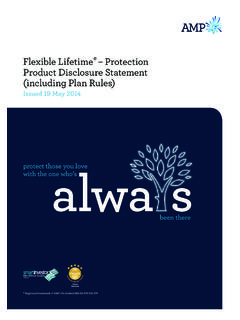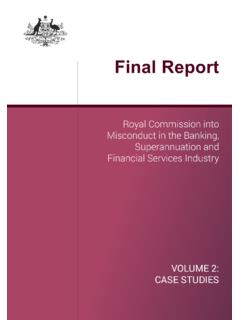Transcription of Fat Cat Funds Report - Stockspot
1 2016 Fat Cat Funds Report | s Fat Cat Funds Report is the largest analysis of Australian superannuation and managed Funds . This is the fourth year Stockspot has run the Fat Cat Funds Report and this year we look at a record 3,800 Funds to assess how they have performed after fees over the past 5 purpose of this Report is to bring to light the issues of high fees, poor transparency and conflicts of interest within the wealth management industry in Australia believe Australians deserve greater visibility around where their money is invested and how it is performing. The conflicts of interest that exist due to the vertical integration of product and advice providers has led to a situation where poor performing products often slip under the radar of have rated Funds based how they have objectively performed relative to their peers over one, three and five years. Based on this we have categorised Funds into five groups, of which we believe two warrant extra Cat Funds : Funds that have beaten their peer group over one, three and five years and by more than 10% over the entire Cat Funds : Funds that performed worse than their peer group over one, three and five years and underperformed by more than 10% over the entire Brycki Founder at Stockspot2 Stockspot Fat Cat Funds Report - 2016 There is a serious message at the heart of this Report .
2 Too many Australians are unaware of the devastating impact high fees have on their long term savings. Too many Funds , 638 of them, have repeatedly proven their inability to deliver even index of this is because Funds management is extremely competitive. As more fund managers have joined the industry, it has become increasingly difficult to beat the market because they are the market. Investing is a zero sum game and over the long term fund managers in total can only earn the market return minus their fees. After fees are removed, about 75% of them do worse than the market index itself on any given Report shows that the biggest impact to consumers comes from Funds with high compounding fees. Given that superannuation is the single most important savings pot you will have in your life surely this is an issue that needs urgent attention from Government? Stockspot has been campaigning to raise awareness of the effect of Fat Cat Funds on everyday Australians.
3 By shining a light on the Fat Cat Funds our aim is to effect some change. Either by Funds reducing their fees, by encouraging consumers to consider their options, or by Government intervening to improve fairness and for consumers, almost nothing has changed since our first Report in 2013 as the big four banks and AMP continue to dominate the distribution of Fat Cat the introduction of the Future of Financial Advice (FoFA) legislation in 2013 which was aimed to help consumers, many Australians life savings remain trapped in Funds that have consistently underperformed their peers and benchmarks, largely due to their fees. A significant amount of consumer savings remains in grandfathered products with high fees rather than the low fee versions of these products that are now available. We found many examples of high-fee Funds that have been closed to new investors for years but that still have over 5x the amount of customer money in them compared to their new low-fee Report comes as there are growing calls for a Royal Commission into banking misconduct.
4 It is clear from our research that the scale of the conflicts of interest are so deeply embedded in Australia s financial institutions that the impact is harming people. The conflicts in financial advice caused by bank vertical integration combined with poor financial literacy has led to a situation where many Australians will not be able to afford a comfortable retirement due to the impact of fees over their | believe government should intervene to improve fairness in two ways by: Requiring all superannuation and managed fund products to provide their fee and performance data in a standardised format to a government fund comparison website so that consumers can easily compare their options. At the moment it s almost impossible to see how different products are really performing because the data isn t available in a standardised format. Implementing a public tender process for the right to manage default super , there is some change from consumers as people become more disenchanted with managed fund platforms.
5 More self-directed investors and independent financial advisers access products directly via fund managers, Exchange Traded Funds (ETFs), Listed Investment Companies (LICs), automated investment services like Stockspot , or the mFund Settlement Service, often greatly reducing their upfront and ongoing final word - it would be unfair to run the Fat Cat Report without celebrating the Fit Cat Funds . These are Funds that have done consistently well for their customers by outperforming their benchmarks. They set an example of best practice that the rest of the industry should welcome all feedback on the Report and hope you find our website useful to discover and compare over 3,800 different Funds - Stockspot Fat Cat Funds Report - 2016 ContentsForeword2 How We Identify Fat Cat Funds6 Research Highlights8 Performance vs. Fees10 Industry vs. Retail Super Funds11 What Fees Mean For A 30, 40 and 50 Year Old13 What Fees Mean By State16 What Fees Mean By Profession17 Fat Cat Funds18 Fat Cat Awards19 Fit Cat Funds20 Fit Cat Awards21 Top Performing Fit Cat Funds22 Should You Leave A Fat Cat fund ?
6 23 superannuation Funds24 Shares - Asia Pacific ex Japan25 Shares - Australia26 Shares - Emerging Markets27 Shares - Global28 Shares - Infrastructure29 Mixed Asset - Cautious30 Mixed Asset - Moderate31 Mixed Asset - Balanced32 Mixed Asset - Growth33 Mixed Asset - Aggressive34 Property - Australia35 Property - Global36 Managed Funds37 Shares - Asia Pacific ex Japan38 Shares - Australia39 Shares - Emerging Markets40 Shares - Global41 Shares - Infrastructure42 Mixed Asset - Cautious43 Mixed Asset - Moderate44 Mixed Asset - Balanced45 Mixed Asset - Growth46 Mixed Asset - Aggressive47 Property - Australia48 Property - Global49 About | We Identify Fat Cat FundsStockspot s Fat Cat ratings are based solely on statistical criteria relating to a fund s past performance. Here we explain the methodology. Over the last couple of decades the fund management industry has become increasingly competitive. Markets trade globally around the clock, information is available within seconds and large companies in particular are analysed in detail by scores of analysts at banks, brokers and fund managers all of whom are trying to find an is unsurprising then that fund managers need to be really good just to be average.
7 If you are going to invest in actively managed Funds , you need to be very selective in choosing those managers with the skill to deliver superior returns that justify their fees. Most fund managers do not achieve this over the long Fat Cat Funds Report is focused on identifying those Funds that warrant special attention because they have consistently underperformed compared to their peers over a reasonable time period of five have analysed Australian domiciled superannuation Funds and Managed Investment Funds across 12 categories. We only consider Funds that have available data on performance and fees and have existed for at least five years. Due to a lack of like-for-like benchmarks, geared Funds have been excluded from the awards. fund performance data is as at 30 June 2016. Funds are categorised using their underlying asset allocation, with the grouping of mixed asset Funds based on how much of the fund s portfolio is invested in growth assets (shares and property) Conservative: 20% or less Moderate: 21% to 40% Balanced: 41% to 60% Growth: 61% to 80% Aggressive: More than 80%OUR UNIVERSE AND BENCHMARKS 6 Stockspot Fat Cat Funds Report - 2016 FAT CAT FUNDSFLABBY CAT FUNDSWe apply two filters to identify Fat Cat Funds .
8 First we filter those Funds that have failed to outperform the average cumulative return in their category over one, three and five years. This filter is used to highlight those Funds that have consistently underperformed and to strip out those that may simply have had a short-run of bad luck. For the second filter, the fund must have underperformed its category average return by 10% or more over the entire five-year period of the past five years these Funds have more often than not performed worse than the category Funds have performed around the middle of the pack over the past five the past 5 years these Funds have performed better than the category average more often than also want to acknowledge the Funds which consistently perform well over long periods. To be consistent we employed the opposite filter to Fat Cat Funds to identify top performing Funds . First we filter the fund universe to identify Funds that outperformed the average cumulative return in their category over one, three and five years.
9 We then apply a second filter: the fund must have outperformed its category average return by 10% or more over the entire five-year CAT FUNDSFINE CAT FUNDSFIT CAT | Highlights Total investment fees Australians pay to superannuation Funds each ,820 Different Funds analysed$587 billion Total Funds analysed$ billion Total fees counted$ billion$$$$8 Stockspot Fat Cat Funds Report - 2016638 Fat Cat $777,766,071 $59,436,468,695 Fees paid to Fat Cat Funds each yearUp from $ in 2015 Money managed by Fat Cat FundsDown from 701 in 2015Up from in 2015$$Down from $791M in 2015 Average fees charged by Fat Cat | Pre-Fee PerformanceAverage FeeAfter-Fee PerformancePre-Fee PerformanceAverage FeeAfter-Fee PerformanceFat Cat FundsFit Cat Funds0%4%7%11%14% Pre-Fee PerformanceAverage FeeAfter-Fee PerformancePre-Fee PerformanceAverage FeeAfter-Fee PerformanceFat Cat FundsFit Cat Funds0%4%7%11%14% vs. FeesFees Charged0 - - - - - plus% of Funds which are Fat Cats 5%18%11%18%20%36%% of Funds which are Fit Cats34%23%21%8%10%5%How much of your return is lost in feesHow much of your return is lost in fees28%12%AVERAGE RETURNS OVER 5 YEARS10 Stockspot Fat Cat Funds Report - 2016 Retail Super FundsIndustry Super FundsIndustry vs.
10 Retail Super Funds17%Fat CatsFlabby CatsFair CatsFine CatsFit Cats9%4%16%34%38%22%28%18%14% | HAS MORE FAT CATS - RETAIL OR INDUSTRY SUPER Funds ? Pre-Fee PerformanceAverage FeeAfter-Fee PerformancePre-Fee PerformanceAverage FeeAfter-Fee PerformanceRetail Super FundsIndustry Super Funds0%4%7%11%14% Pre-Fee PerformanceAverage FeeAfter-Fee PerformancePre-Fee PerformanceAverage FeeAfter-Fee PerformanceRetail Super FundsIndustry Super Funds0%4%7%11%14% BEFORE AND AFTER FEESCOMMENTARYHow much of your return is lost in feesHow much of your return is lost in fees17%8%Industry Super Funds have on average charged lower fees and generated higher after-fee returns than Retail Super Funds . In all investment sectors apart from Australian Property, Retail Super Funds have had more Fat Cat Funds than Industry Super Funds . Retail Super Funds seem to do well in generating pre-fee returns, however any advantage is lost because of the high fees they TypeLargest % of Fat Cat FundsSharesAustraliaRetail superEmergingRetail superGlobalRetail superInfrastructureRetail superMixed AssetAggressiveRetail superBalancedRetail superCautiousRetail superGrowthRetail superModerateRetail superPropertyAustraliaIndustry superGlobalRetail superIndustry vs.








